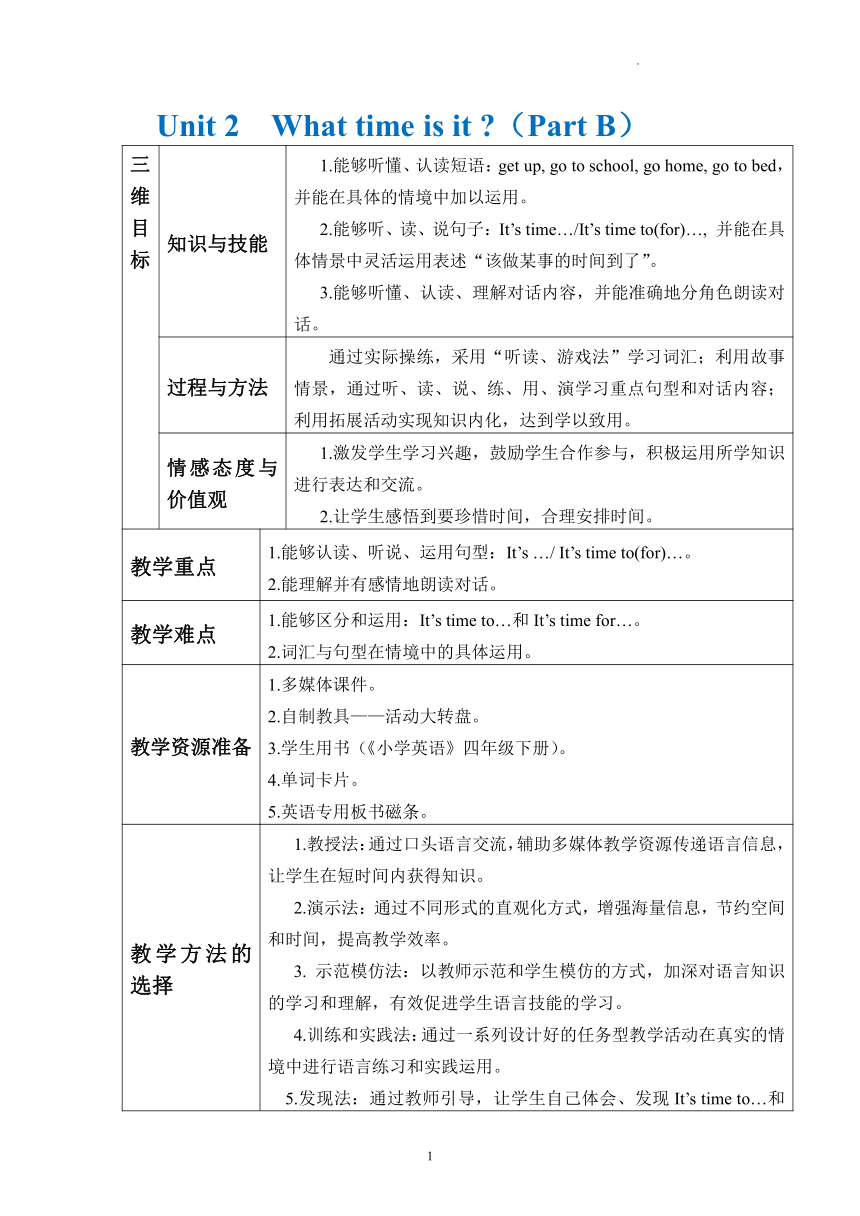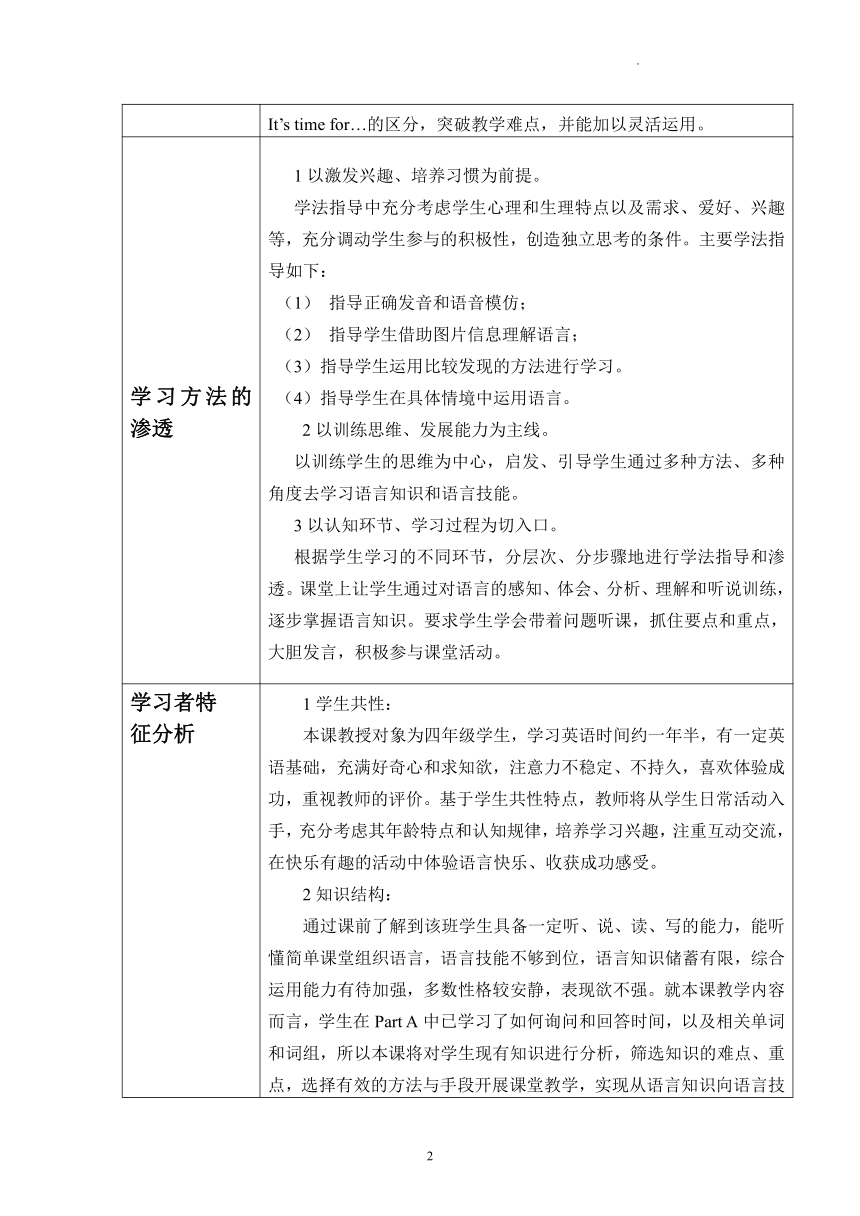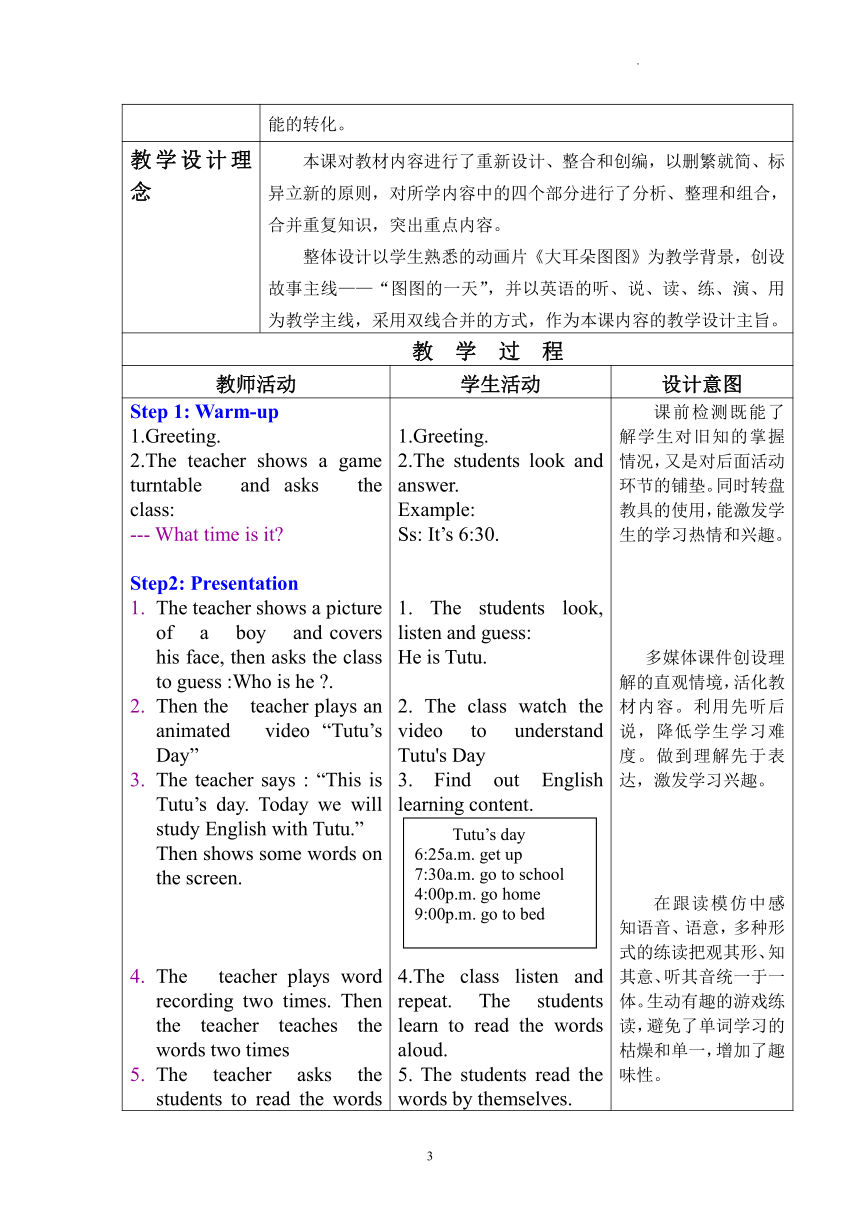Unit2 What time is it?PartB Let's learn教案(表格式)
文档属性
| 名称 | Unit2 What time is it?PartB Let's learn教案(表格式) |  | |
| 格式 | zip | ||
| 文件大小 | 36.9KB | ||
| 资源类型 | 教案 | ||
| 版本资源 | 人教版(PEP) | ||
| 科目 | 英语 | ||
| 更新时间 | 2022-04-25 22:33:54 | ||
图片预览



文档简介
Unit 2 What time is it (Part B)
三维目标 知识与技能 1.能够听懂、认读短语:get up, go to school, go home, go to bed, 并能在具体的情境中加以运用。 2.能够听、读、说句子:It’s time…/It’s time to(for)…, 并能在具体情景中灵活运用表述“该做某事的时间到了”。 3.能够听懂、认读、理解对话内容,并能准确地分角色朗读对话。
过程与方法 通过实际操练,采用“听读、游戏法”学习词汇;利用故事情景,通过听、读、说、练、用、演学习重点句型和对话内容;利用拓展活动实现知识内化,达到学以致用。
情感态度与价值观 1.激发学生学习兴趣,鼓励学生合作参与,积极运用所学知识进行表达和交流。 2.让学生感悟到要珍惜时间,合理安排时间。
教学重点 1.能够认读、听说、运用句型:It’s …/ It’s time to(for)…。 2.能理解并有感情地朗读对话。
教学难点 1.能够区分和运用:It’s time to…和It’s time for…。 2.词汇与句型在情境中的具体运用。
教学资源准备 1.多媒体课件。 2.自制教具——活动大转盘。 3.学生用书(《小学英语》四年级下册)。 4.单词卡片。 5.英语专用板书磁条。
教学方法的选择 1.教授法:通过口头语言交流,辅助多媒体教学资源传递语言信息,让学生在短时间内获得知识。 2.演示法:通过不同形式的直观化方式,增强海量信息,节约空间和时间,提高教学效率。 3. 示范模仿法:以教师示范和学生模仿的方式,加深对语言知识的学习和理解,有效促进学生语言技能的学习。 4.训练和实践法:通过一系列设计好的任务型教学活动在真实的情境中进行语言练习和实践运用。 5.发现法:通过教师引导,让学生自己体会、发现It’s time to…和It’s time for…的区分,突破教学难点,并能加以灵活运用。
学习方法的渗透 1以激发兴趣、培养习惯为前提。 学法指导中充分考虑学生心理和生理特点以及需求、爱好、兴趣等,充分调动学生参与的积极性,创造独立思考的条件。主要学法指导如下: (1) 指导正确发音和语音模仿; (2) 指导学生借助图片信息理解语言; (3)指导学生运用比较发现的方法进行学习。 (4)指导学生在具体情境中运用语言。 2以训练思维、发展能力为主线。 以训练学生的思维为中心,启发、引导学生通过多种方法、多种角度去学习语言知识和语言技能。 3以认知环节、学习过程为切入口。 根据学生学习的不同环节,分层次、分步骤地进行学法指导和渗透。课堂上让学生通过对语言的感知、体会、分析、理解和听说训练,逐步掌握语言知识。要求学生学会带着问题听课,抓住要点和重点,大胆发言,积极参与课堂活动。
学习者特 征分析 1学生共性: 本课教授对象为四年级学生,学习英语时间约一年半,有一定英语基础,充满好奇心和求知欲,注意力不稳定、不持久,喜欢体验成功,重视教师的评价。基于学生共性特点,教师将从学生日常活动入手,充分考虑其年龄特点和认知规律,培养学习兴趣,注重互动交流,在快乐有趣的活动中体验语言快乐、收获成功感受。 2知识结构: 通过课前了解到该班学生具备一定听、说、读、写的能力,能听懂简单课堂组织语言,语言技能不够到位,语言知识储蓄有限,综合运用能力有待加强,多数性格较安静,表现欲不强。就本课教学内容而言,学生在Part A中已学习了如何询问和回答时间,以及相关单词和词组,所以本课将对学生现有知识进行分析,筛选知识的难点、重点,选择有效的方法与手段开展课堂教学,实现从语言知识向语言技能的转化。
教学设计理念 本课对教材内容进行了重新设计、整合和创编,以删繁就简、标异立新的原则,对所学内容中的四个部分进行了分析、整理和组合,合并重复知识,突出重点内容。 整体设计以学生熟悉的动画片《大耳朵图图》为教学背景,创设故事主线——“图图的一天”,并以英语的听、说、读、练、演、用为教学主线,采用双线合并的方式,作为本课内容的教学设计主旨。
教 学 过 程
教师活动 学生活动 设计意图
Step 1: Warm-up 1.Greeting. 2.The teacher shows a game turntable and asks the class: --- What time is it Step2: Presentation The teacher shows a picture of a boy and covers his face, then asks the class to guess :Who is he . Then the teacher plays an animated video “Tutu’s Day” The teacher says : “This is Tutu’s day. Today we will study English with Tutu.” Then shows some words on the screen. The teacher plays word recording two times. Then the teacher teaches the words two times The teacher asks the students to read the words by themselves. The teacher uses the electronic whiteboard searchlight function to show words. The Teacher shows some sentences and plays word recording. (1)It’s 6:25.It’s time to get up. (2)It’s 7:30.It’s time to go to school. (3)It’s 4:00.It’s time to go home. (4)It’s 9:00.It’s time to go to bed . 8. The teacher shows the words, the pictures and the sentences: ---- It’s….It’s time to …. ----It’s….It’s time for …. Then The teacher asks the students to sum up the rules. 9 Ask the students to read the sentences. Step 3: Practice and game 1. The teacher plays the flash and asks the student to read the words quickly and loudly. 2. The teacher shows a game turntable and asks the student to ask and answer. 3. The teacher plays the dialogue. 4.The teacher plays the dialogue again. 5.The teacher divides the class into some small groups. And ask the students to read the dialogue. 6. The teacher asks the students to play Mum, Mike, Miss White and a student, then read the dialogue. 7.The teacher asks the students to act out the dialogue Step4:Development Activities 1.The teacher shows a video and tell the students on how to say one day in English My day I get up at … I go to school at … I go home at… I go to bed at.. 2.Give the students some time to discuss how to say one day in pairs. Then ask several students in each group to speak English. 3. The teacher records video for students. Step5: Summary and homework: Summary 1.words: a.m., p.m. , get up, go to school, go home, go to bed. 2. Knowledge Points. It’s time to +动词原形 It’s time for +名词 3 Homework: (1)听读课本第17、18页的内容。 (2)观看老师分享的视频。 (3)采取不同的形式完成My day 口头练说。(三选一) 习作练写。 录制视频。 4T: That’s all for today. Class is over. Goodbye. Thank you, boys and girls. 1.Greeting. 2.The students look and answer. Example: Ss: It’s 6:30. 1. The students look, listen and guess: He is Tutu. 2. The class watch the video to understand Tutu's Day 3. Find out English learning content. (
Tutu’s day
6:25a.m. get up
7:30a.m. go to school
4:00p.m. go home
9:00p.m. go to bed
) 4.The class listen and repeat. The students learn to read the words aloud. 5. The students read the words by themselves. The students look and read the words. 7. The students look, listen and repeat them. The students listen and read sentences. 8.The students practice sentences according to the words and pictures. The students get the rules by practicing some sentences : It’s time to +动词原形 It’s time for +名词 9.The students look and read the sentences. 1.The students look and read the words. 2 Two students ask and answer: Example: S1: What time is it S2: It’s 6:30. It’s time to get up. 3.The students look and listen carefully. 4.The students listen and repeat. 5.The students read the dialogue. 6.The students dubbing the conversation. Example: Student 1 will be Mum Student 2 will be Mike. Student 3 will be Miss White . Student4 will be student. 7.The Students act the dialogue. 1.The students look and understand how to say. 2.The students discuss in pairs and say. 3.The students say “My day.” 1.The students look and read the words all together. 2.The students can understand the differences between the two sentences 3.The students write down the homework. 4 Ss: Good bye, teacher. 课前检测既能了解学生对旧知的掌握情况,又是对后面活动环节的铺垫。同时转盘教具的使用,能激发学生的学习热情和兴趣。 多媒体课件创设理解的直观情境,活化教材内容。利用先听后说,降低学生学习难度。做到理解先于表达,激发学习兴趣。 在跟读模仿中感知语音、语意,多种形式的练读把观其形、知其意、听其音统一于一体。生动有趣的游戏练读,避免了单词学习的枯燥和单一,增加了趣味性。 提供语言实践机会,鼓励学生积极参加,大胆说练。 通过实际操练,实现知识内化;利用真实运用,促进思维发展,引导学生探究性地学习英语,在掌握语言学习的规律,熟悉语言表达的模式后,发现不同,学会区分和运用,达到学以致用。 针对小学生喜奇、好动、爱游戏的特点,利用游戏的方式呈现语言知识,在有趣的游戏活动中进一步巩固重点知识的认读和理解。 利用游戏的形式激发学生主动参与的积极性和欲望,让学生在轻松愉悦的氛围中灵活地运用语言知识。 通过多种形式的练读操练,培养学生听音、跟读和模仿的能力。 拓宽对话教学的途径和方法,增加对话教学的趣味性、开放性、实效性,在对话活动中在突出重点、强化重点,为对话的顺利学习提供有利保障。 不拘泥于教材,对所学知识进行相应的拓展和延伸,在学生完全掌握当堂所学教材文本的基础上,对新内容进行创造性地运用。 小结本课堂的学习内容,给学生一个完整的轮廓,在巩固知识的同时,为运用知识和后续学习做铺垫。 作业内容有层次性,书本内容和拓展内容相结合;作业完成方式有选择性,练说、练写、表演三选一, 作业倡导学以致用,注重调动学生的积极性。
板书设计: Unit 2 What time is it get up go to school go home go to bed It’s time to +动词原形 It’s time for + 名词
18
三维目标 知识与技能 1.能够听懂、认读短语:get up, go to school, go home, go to bed, 并能在具体的情境中加以运用。 2.能够听、读、说句子:It’s time…/It’s time to(for)…, 并能在具体情景中灵活运用表述“该做某事的时间到了”。 3.能够听懂、认读、理解对话内容,并能准确地分角色朗读对话。
过程与方法 通过实际操练,采用“听读、游戏法”学习词汇;利用故事情景,通过听、读、说、练、用、演学习重点句型和对话内容;利用拓展活动实现知识内化,达到学以致用。
情感态度与价值观 1.激发学生学习兴趣,鼓励学生合作参与,积极运用所学知识进行表达和交流。 2.让学生感悟到要珍惜时间,合理安排时间。
教学重点 1.能够认读、听说、运用句型:It’s …/ It’s time to(for)…。 2.能理解并有感情地朗读对话。
教学难点 1.能够区分和运用:It’s time to…和It’s time for…。 2.词汇与句型在情境中的具体运用。
教学资源准备 1.多媒体课件。 2.自制教具——活动大转盘。 3.学生用书(《小学英语》四年级下册)。 4.单词卡片。 5.英语专用板书磁条。
教学方法的选择 1.教授法:通过口头语言交流,辅助多媒体教学资源传递语言信息,让学生在短时间内获得知识。 2.演示法:通过不同形式的直观化方式,增强海量信息,节约空间和时间,提高教学效率。 3. 示范模仿法:以教师示范和学生模仿的方式,加深对语言知识的学习和理解,有效促进学生语言技能的学习。 4.训练和实践法:通过一系列设计好的任务型教学活动在真实的情境中进行语言练习和实践运用。 5.发现法:通过教师引导,让学生自己体会、发现It’s time to…和It’s time for…的区分,突破教学难点,并能加以灵活运用。
学习方法的渗透 1以激发兴趣、培养习惯为前提。 学法指导中充分考虑学生心理和生理特点以及需求、爱好、兴趣等,充分调动学生参与的积极性,创造独立思考的条件。主要学法指导如下: (1) 指导正确发音和语音模仿; (2) 指导学生借助图片信息理解语言; (3)指导学生运用比较发现的方法进行学习。 (4)指导学生在具体情境中运用语言。 2以训练思维、发展能力为主线。 以训练学生的思维为中心,启发、引导学生通过多种方法、多种角度去学习语言知识和语言技能。 3以认知环节、学习过程为切入口。 根据学生学习的不同环节,分层次、分步骤地进行学法指导和渗透。课堂上让学生通过对语言的感知、体会、分析、理解和听说训练,逐步掌握语言知识。要求学生学会带着问题听课,抓住要点和重点,大胆发言,积极参与课堂活动。
学习者特 征分析 1学生共性: 本课教授对象为四年级学生,学习英语时间约一年半,有一定英语基础,充满好奇心和求知欲,注意力不稳定、不持久,喜欢体验成功,重视教师的评价。基于学生共性特点,教师将从学生日常活动入手,充分考虑其年龄特点和认知规律,培养学习兴趣,注重互动交流,在快乐有趣的活动中体验语言快乐、收获成功感受。 2知识结构: 通过课前了解到该班学生具备一定听、说、读、写的能力,能听懂简单课堂组织语言,语言技能不够到位,语言知识储蓄有限,综合运用能力有待加强,多数性格较安静,表现欲不强。就本课教学内容而言,学生在Part A中已学习了如何询问和回答时间,以及相关单词和词组,所以本课将对学生现有知识进行分析,筛选知识的难点、重点,选择有效的方法与手段开展课堂教学,实现从语言知识向语言技能的转化。
教学设计理念 本课对教材内容进行了重新设计、整合和创编,以删繁就简、标异立新的原则,对所学内容中的四个部分进行了分析、整理和组合,合并重复知识,突出重点内容。 整体设计以学生熟悉的动画片《大耳朵图图》为教学背景,创设故事主线——“图图的一天”,并以英语的听、说、读、练、演、用为教学主线,采用双线合并的方式,作为本课内容的教学设计主旨。
教 学 过 程
教师活动 学生活动 设计意图
Step 1: Warm-up 1.Greeting. 2.The teacher shows a game turntable and asks the class: --- What time is it Step2: Presentation The teacher shows a picture of a boy and covers his face, then asks the class to guess :Who is he . Then the teacher plays an animated video “Tutu’s Day” The teacher says : “This is Tutu’s day. Today we will study English with Tutu.” Then shows some words on the screen. The teacher plays word recording two times. Then the teacher teaches the words two times The teacher asks the students to read the words by themselves. The teacher uses the electronic whiteboard searchlight function to show words. The Teacher shows some sentences and plays word recording. (1)It’s 6:25.It’s time to get up. (2)It’s 7:30.It’s time to go to school. (3)It’s 4:00.It’s time to go home. (4)It’s 9:00.It’s time to go to bed . 8. The teacher shows the words, the pictures and the sentences: ---- It’s….It’s time to …. ----It’s….It’s time for …. Then The teacher asks the students to sum up the rules. 9 Ask the students to read the sentences. Step 3: Practice and game 1. The teacher plays the flash and asks the student to read the words quickly and loudly. 2. The teacher shows a game turntable and asks the student to ask and answer. 3. The teacher plays the dialogue. 4.The teacher plays the dialogue again. 5.The teacher divides the class into some small groups. And ask the students to read the dialogue. 6. The teacher asks the students to play Mum, Mike, Miss White and a student, then read the dialogue. 7.The teacher asks the students to act out the dialogue Step4:Development Activities 1.The teacher shows a video and tell the students on how to say one day in English My day I get up at … I go to school at … I go home at… I go to bed at.. 2.Give the students some time to discuss how to say one day in pairs. Then ask several students in each group to speak English. 3. The teacher records video for students. Step5: Summary and homework: Summary 1.words: a.m., p.m. , get up, go to school, go home, go to bed. 2. Knowledge Points. It’s time to +动词原形 It’s time for +名词 3 Homework: (1)听读课本第17、18页的内容。 (2)观看老师分享的视频。 (3)采取不同的形式完成My day 口头练说。(三选一) 习作练写。 录制视频。 4T: That’s all for today. Class is over. Goodbye. Thank you, boys and girls. 1.Greeting. 2.The students look and answer. Example: Ss: It’s 6:30. 1. The students look, listen and guess: He is Tutu. 2. The class watch the video to understand Tutu's Day 3. Find out English learning content. (
Tutu’s day
6:25a.m. get up
7:30a.m. go to school
4:00p.m. go home
9:00p.m. go to bed
) 4.The class listen and repeat. The students learn to read the words aloud. 5. The students read the words by themselves. The students look and read the words. 7. The students look, listen and repeat them. The students listen and read sentences. 8.The students practice sentences according to the words and pictures. The students get the rules by practicing some sentences : It’s time to +动词原形 It’s time for +名词 9.The students look and read the sentences. 1.The students look and read the words. 2 Two students ask and answer: Example: S1: What time is it S2: It’s 6:30. It’s time to get up. 3.The students look and listen carefully. 4.The students listen and repeat. 5.The students read the dialogue. 6.The students dubbing the conversation. Example: Student 1 will be Mum Student 2 will be Mike. Student 3 will be Miss White . Student4 will be student. 7.The Students act the dialogue. 1.The students look and understand how to say. 2.The students discuss in pairs and say. 3.The students say “My day.” 1.The students look and read the words all together. 2.The students can understand the differences between the two sentences 3.The students write down the homework. 4 Ss: Good bye, teacher. 课前检测既能了解学生对旧知的掌握情况,又是对后面活动环节的铺垫。同时转盘教具的使用,能激发学生的学习热情和兴趣。 多媒体课件创设理解的直观情境,活化教材内容。利用先听后说,降低学生学习难度。做到理解先于表达,激发学习兴趣。 在跟读模仿中感知语音、语意,多种形式的练读把观其形、知其意、听其音统一于一体。生动有趣的游戏练读,避免了单词学习的枯燥和单一,增加了趣味性。 提供语言实践机会,鼓励学生积极参加,大胆说练。 通过实际操练,实现知识内化;利用真实运用,促进思维发展,引导学生探究性地学习英语,在掌握语言学习的规律,熟悉语言表达的模式后,发现不同,学会区分和运用,达到学以致用。 针对小学生喜奇、好动、爱游戏的特点,利用游戏的方式呈现语言知识,在有趣的游戏活动中进一步巩固重点知识的认读和理解。 利用游戏的形式激发学生主动参与的积极性和欲望,让学生在轻松愉悦的氛围中灵活地运用语言知识。 通过多种形式的练读操练,培养学生听音、跟读和模仿的能力。 拓宽对话教学的途径和方法,增加对话教学的趣味性、开放性、实效性,在对话活动中在突出重点、强化重点,为对话的顺利学习提供有利保障。 不拘泥于教材,对所学知识进行相应的拓展和延伸,在学生完全掌握当堂所学教材文本的基础上,对新内容进行创造性地运用。 小结本课堂的学习内容,给学生一个完整的轮廓,在巩固知识的同时,为运用知识和后续学习做铺垫。 作业内容有层次性,书本内容和拓展内容相结合;作业完成方式有选择性,练说、练写、表演三选一, 作业倡导学以致用,注重调动学生的积极性。
板书设计: Unit 2 What time is it get up go to school go home go to bed It’s time to +动词原形 It’s time for + 名词
18
